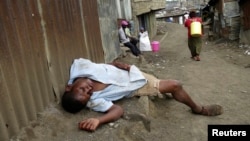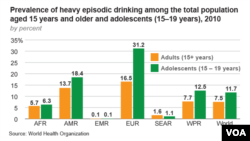GENEVA —
The World Health Organization is urging nations to take action to reduce the harmful effects of alcohol, which it says is killing 3.3 million people each year.
The WHO reports the harmful use of alcohol is responsible for six percent of all deaths around the world - that is one death every 10 seconds.
Besides being addictive, the report says alcohol consumption increases the risk of developing more than 200 diseases, including liver cirrhosis and some cancers. For the first time, the WHO says the harmful use of alcohol makes people more susceptible to infectious diseases, such as tuberculosis, pneumonia and HIV.
WHO Mental Health and Substance Abuse Director Shekhar Saxena says the organization is concerned about drinking among young adults between ages 15 and 19, and particularly by heavy episodic drinking or “binge-drinking. ”
"The report concludes that worldwide 16 percent of drinkers over the age of 15 engage in binge-drinking, which is much more harmful than other kind of drinking ... which causes the most harm in terms of accidents, self-harm and harm to others ... High income countries have the highest alcohol per capita consumption and also the highest prevalence of binge-drinking,” said Saxena.
The report notes on average every person aged 15 or older drinks 6.2 liters of alcohol per year, but since less than 50 percent of the population drinks alcohol, those who do, consume on average 17 liters of pure alcohol a year.
The report warns drinking is increasing among women and this is of concern as they are more vulnerable to some alcohol-related health conditions than men. The highest rates of mortality are found in Europe, followed by the West Pacific and then the Americas region.
Globally, the report finds Europe is the region with the highest alcohol consumption, particularly in Central and Eastern parts, followed by the Americas and Africa. It says Russia, Ukraine, Belarus, Moldova, and some neighboring countries have very high levels of consumption and binge drinking.
Although less alcohol is consumed in Africa than in Europe, WHO Management of Substance Abuse Coordinator Vladimir Poznyak says the health impacts are worse in Africa than in Europe.
“The difference is that in African region as well as in other countries with less resources, the consumption of alcohol brings more harm to health and to social relationship because of the absence of buffering factors, which are often like social support, like access to health care services. This what is lacking,” said Poznyak.
The World Health Organization is urging countries to strengthen measures to protect people from the harmful effects of alcohol abuse. These include increasing taxes on alcohol, raising the drinking age limit, and regulating the marketing of alcoholic beverages.
The WHO reports the harmful use of alcohol is responsible for six percent of all deaths around the world - that is one death every 10 seconds.
Besides being addictive, the report says alcohol consumption increases the risk of developing more than 200 diseases, including liver cirrhosis and some cancers. For the first time, the WHO says the harmful use of alcohol makes people more susceptible to infectious diseases, such as tuberculosis, pneumonia and HIV.
WHO Mental Health and Substance Abuse Director Shekhar Saxena says the organization is concerned about drinking among young adults between ages 15 and 19, and particularly by heavy episodic drinking or “binge-drinking. ”
"The report concludes that worldwide 16 percent of drinkers over the age of 15 engage in binge-drinking, which is much more harmful than other kind of drinking ... which causes the most harm in terms of accidents, self-harm and harm to others ... High income countries have the highest alcohol per capita consumption and also the highest prevalence of binge-drinking,” said Saxena.
The report notes on average every person aged 15 or older drinks 6.2 liters of alcohol per year, but since less than 50 percent of the population drinks alcohol, those who do, consume on average 17 liters of pure alcohol a year.
The report warns drinking is increasing among women and this is of concern as they are more vulnerable to some alcohol-related health conditions than men. The highest rates of mortality are found in Europe, followed by the West Pacific and then the Americas region.
Globally, the report finds Europe is the region with the highest alcohol consumption, particularly in Central and Eastern parts, followed by the Americas and Africa. It says Russia, Ukraine, Belarus, Moldova, and some neighboring countries have very high levels of consumption and binge drinking.
Although less alcohol is consumed in Africa than in Europe, WHO Management of Substance Abuse Coordinator Vladimir Poznyak says the health impacts are worse in Africa than in Europe.
“The difference is that in African region as well as in other countries with less resources, the consumption of alcohol brings more harm to health and to social relationship because of the absence of buffering factors, which are often like social support, like access to health care services. This what is lacking,” said Poznyak.
The World Health Organization is urging countries to strengthen measures to protect people from the harmful effects of alcohol abuse. These include increasing taxes on alcohol, raising the drinking age limit, and regulating the marketing of alcoholic beverages.


